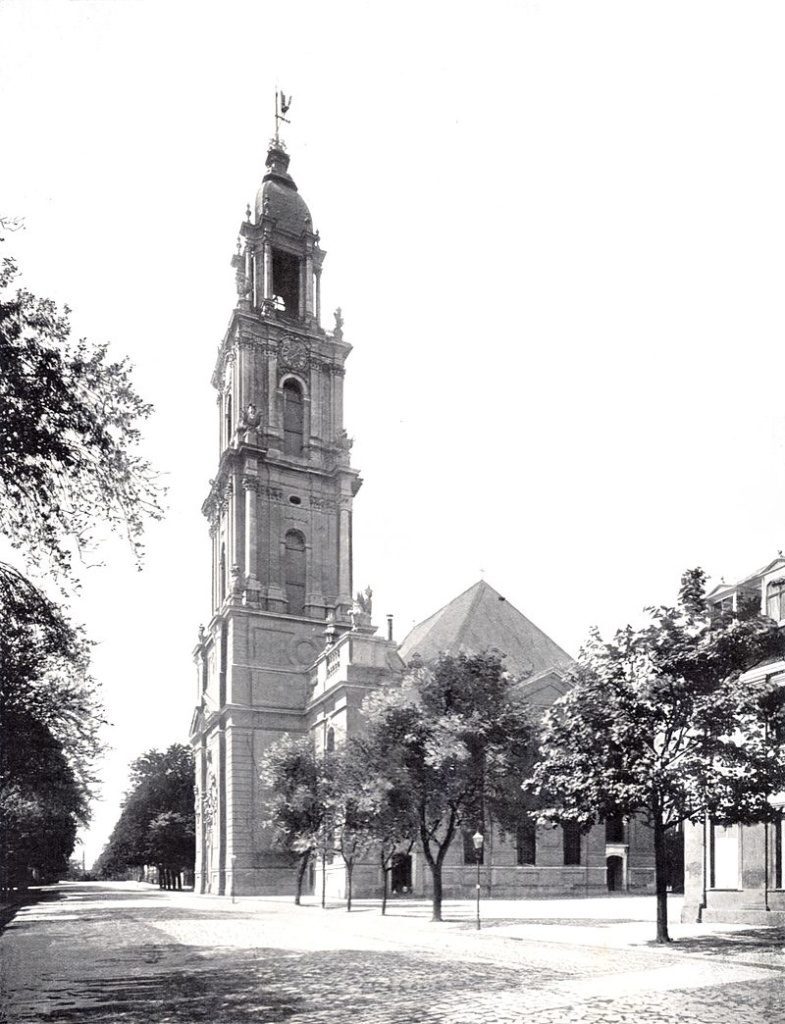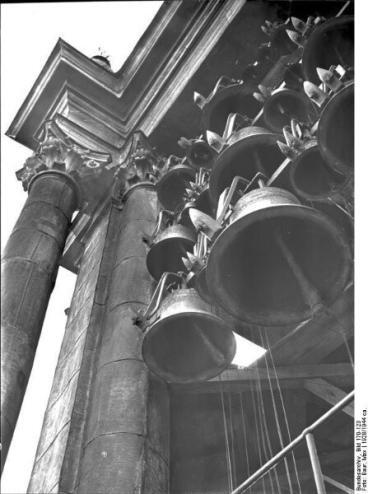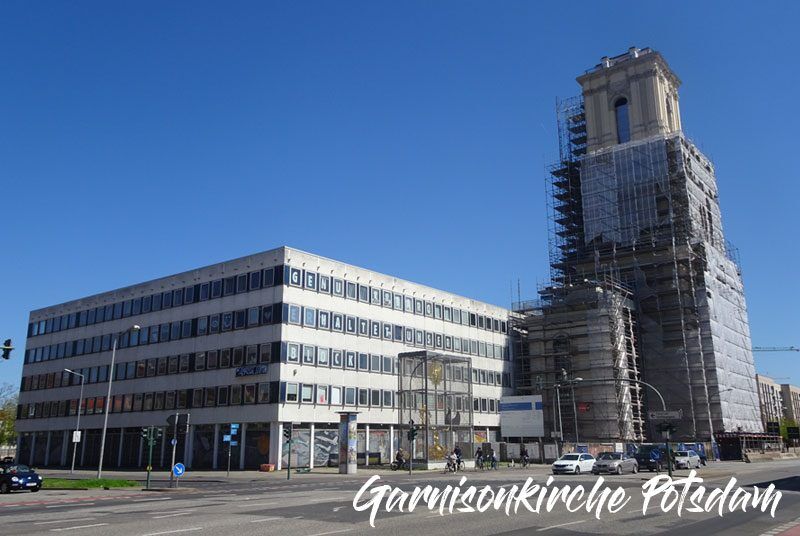Garrison Church Potsdam | Information, history and pictures
Discover the fascinating history and impressive architecture of the Garrison Church in Potsdam! As one of the city’s most significant buildings, it is back in the public eye with its planned reconstruction. Learn more about the rich history, unique architecture, and other exciting facts about this Potsdam landmark.
Table of contents
History of the Garrison Church Potsdam

The Garrison Church Potsdam, built by architect Philipp Gerlach between 1730 and 1735 by order of the Prussian King Friedrich Wilhelm I, replaced the half-timbered church from 1722 that previously stood at the same location. It served as a place of worship for the court and the garrison in the residence.
On July 4, 1816, military and civilians celebrated the liberation from the French in the presence of Friedrich Wilhelm III. Captured flags, standards, and plaques with the names of the fallen were displayed on the walls. A marble-clad niche commemorated the alliance between Prussia, Russia, and Austria, displaying the coats of arms of the “three black eagles.”
Both Protestant denominations, Reformed and Lutheran, held separate services since the construction of the Garrison Church. On Reformation Day 1817, the king participated in a service to unify the denominations into the United Church. The altar, previously adorned only with an open Bible, now bore a crucifix and two candlesticks as external symbols of this unity.
The condition of the interior deteriorated by the end of the 19th century. The numerous visitors to the gravesite of Prussia’s most significant kings necessitated renovation urgently.
The appropriation of the Garrison Church by the Nazis strongly shapes historical consciousness. Adolf Hitler and Paul von Hindenburg jointly opened the Reichstag on March 21, 1933, at this symbolic location to place the “Third Reich” in succession to Prussia. This led to the association of the “Spirit of Potsdam” with Prussian militarism and expansionism.
The heavy bombing of Potsdam in April 1945 aimed not only at the city but also at a symbol of Prussia. Although the church itself was not hit, the tower caught fire from sparks, causing the famous carillon to plummet and inflicting significant damage on the historic center and the eastern bank of the Havel.
Demolition of the Garrison Church in Potsdam
After the war, the people of Potsdam could still see the ruins of the burned-out Garrison Church, where a makeshift Holy Cross Chapel was set up in the tower. However, in June 1967, Walter Ulbricht ordered: “That thing must go.” Prussia’s past was to be erased. Despite the resistance of the church community, demolition was enforced.
On May 14, 1968, the royal crypt was first demolished, followed by the church nave. Today, a road with heavy traffic runs at this location, and the former cityscape, characterized by church towers, is no longer recognizable.
Architecture and Construction
The Garrison Church was constructed of bricks, with decorative elements made of sandstone. The sides of the transverse hall were divided by five tall round-arched windows. To integrate these into the church building, staircases were located on both sides of the tower. The pinnacle was crowned by a weather vane showing an eagle flying towards the sun and bearing the monogram of Friedrich Wilhelm I. This flag not only referred to the king’s motto: “Nec soli cedit” – he does not yield even to the sun. It also symbolized the aspiring believer to Christ. At the same time, it was an allusion to the “Sun King” Louis XIV.
Carillon of the Garrison Church

The carillon of the original Garrison Church was reinstalled in the tower. Since 1797, a spiritual melody played at the full hour and a secular one at the half-hour: “Praise the Lord” and “Always Be Faithful and Honest.” You can hear these melodies today at the reconstructed carillon at the same times.
The church had six entrances. However, the particularly ornate tower portal with an inscription was not used. The interior was divided into two side aisles and a central nave, while wooden galleries formed two upper floors. The king and his entourage sat on the first gallery opposite the pulpit and organ. Below in the ground floor, the queen and her ladies-in-waiting sat, with heating available here in winter. The ground floor was otherwise reserved for the civilian community and the women of officers and soldiers, while the spacious galleries were for the military. The church could accommodate a total of 2800 people.
Originally, the pews had no backs, probably to prevent soldiers from falling asleep. In 1738, a shallow ramp was installed to accommodate the gout-afflicted king in a wheelchair. The king’s Calvinist conviction to keep church furnishings simple aligned well with his frugality. The plain altar stood in the center of the church. In contrast, the king invested large sums in building a monumental pulpit crypt, intended to be integrated with the burial chamber. The royal crypt itself was clad in polished, dark marble. The king had black marble sarcophagi shipped from the Netherlands for himself and his consort, Sophie Dorothea.
Graves
In 1740, Friedrich Wilhelm I was buried in the Garrison Church, while his consort found her final resting place in Berlin. Friedrich II (1740-1786) was buried next to his father against his testamentary wish. This involuntary proximity lasted until 1944. Only in 1991 did both Prussian rulers find separate resting places after being relocated to the ancestral castle of the Hohenzollerns: Friedrich Wilhelm I in the mausoleum at the Peace Church and Friedrich II near Sanssouci.
The Garrison Church became a stage for royal spectacle, a Prussian “place of pilgrimage,” through the burial of the Soldier King. In a dramatic scene at the grave of Frederick II, Tsar Alexander I and Friedrich Wilhelm III
(1797-1840) allied against Napoleon in 1805. The victorious French emperor visited the church himself a year later, where he lingered for a long time in the crypt chamber. His admiration for Frederick II underscored Prussia’s defeat even more clearly. Thus, the Garrison Church became a projection surface for political self-presentation.
The church community had no independent governing bodies and was dependent on the state. Therefore, it could never resist this form of externally controlled use.
Reconstruction
The reconstruction of the Garrison Church is a nationally controversial project in Potsdam, with numerous supporters and opponents as well as a variety of arguments for and against the project. Reconstruction of the church tower began on October 29, 2017, and after four and a half years of construction, the 90-meter tower was completed in its shell. The opening is planned for early 2024. Upon completion, the tower will have an observation platform from which one can enjoy a fantastic view over Potsdam, due to the considerable height of the church.

Address
Breite Str. 7, 14467 Potsdam
Tours
Literature
In this richly illustrated work, Andreas Kitschke sheds light on the multifaceted history of the Garrison Church in Potsdam. From its original construction under the reign of the Soldier King Friedrich Wilhelm I to its tragic destruction in the “Night of Potsdam,” as well as the influence of a new spirit after the war, Kitschke spans the arc to the abrupt end in 1968 and the controversial reconstruction plans. His examination goes beyond the architecture, artistic furnishings, and significance of the church in Potsdam’s baroque cityscape. He also considers the historical and cultural events that unfolded in this significant building.

